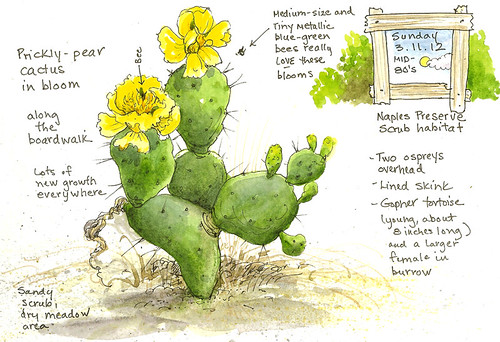This native cactus grows throughout Florida, growing both wild and cultivated. I sketched this prickly pear cactus blooming along the boardwalk at the Naples Preserve. I’ve seen prickly pear growing behind the dunes at the beach, sandy scrub areas like those found at the Preserve and some spots in Rookery Bay, and in pinelands.
Florida has several prickly pear species, and I’m not sure which this might be – possibly Opuntia humifusa (sometimes referred to as Opuntia compressa), which is common throughout the state, as well as the eastern United States, and even northward into Canada. They prefer full sun and well-drained soils, the flattened pads popping right out of the sand.
The pads are jointed together, and are armed with large spines and small hair-like spines called glochids. The clear yellow blooms have numerous stamens at the center, which must have something very delicious to offer – I saw numerous blue-green bees foraging with great abandon! At Naples Preserve, prickly pear also provides food for the resident gopher tortoises, although humans have used it for centuries.
I’m familiar with the edibility of the fruits and pads; one can visit the local supermarket and see both for sale in the produce department in season. I knew that some Opuntia species are home to the cochineal, an insect that produces carminic acid which is used to make a red dye (think carmine red). What I didn’t know was that the plant was used for food, dyestuff, medicine, and trade by the Maya and Aztec peoples.
More recently, Luther Burbank developed a spineless variety of Opuntia in the early 1900’s. He suggested that all of the parts of this versatile cactus could be used. The more I read about this plant, the more I realize that prickly pear cactus is a useful and fascinating plant. I’m not going to be able to tell you all about this cactus in one blog post, so I hope you’ll have a chance to explore on your own.
Elizabeth Smith ~ Naples, Florida, USA
Links for more information:
Wikipedia, on Opuntia species.
Cochineal insects see what they look like and how to dye with them.
WikiHow: Preparing prickly pear for eating


A truly versatile plant and lovely sketch! I will be at Outer Banks for a week in May with no agenda whatsoever; I hope to fill at least one sketchbook with drawings from hikes and excursions.
ReplyDeleteWhat a wonderful post, Elizabeth, thank you. Beautiful image...
ReplyDeleteThanks, Carole! I envy you your week of no agendas - it sounds heavenly...can't wait to see what comes from it!
ReplyDeleteKate - thank you! And thank YOU for this wonderful blog platform where we can share nature artists' experiences from all over the world.
Elizabeth, I love this sketch. It's so lively!
ReplyDelete